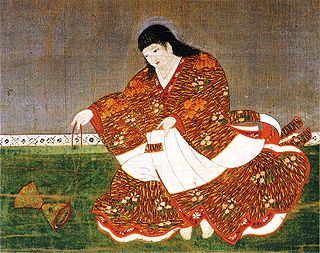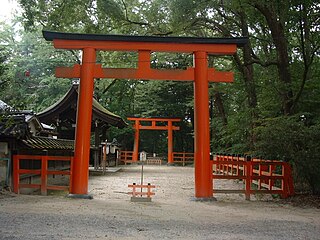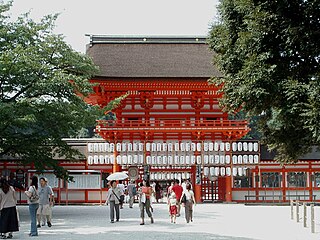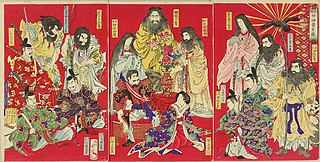Contents
| |||||
| Decades: | |||||
|---|---|---|---|---|---|
| See also: | Other events of 1599 History of Japan • Timeline • Years | ||||
Events in the year 1599 in Japan .
| |||||
| Decades: | |||||
|---|---|---|---|---|---|
| See also: | Other events of 1599 History of Japan • Timeline • Years | ||||
Events in the year 1599 in Japan .

Emperor Seiwa was the 56th emperor of Japan, according to the traditional order of succession.

Emperor Sutoku was the 75th emperor of Japan, according to the traditional order of succession.

Emperor Go-Nara was the 105th Emperor of Japan, according to the traditional order of succession. He reigned from June 9, 1526, until his death in 1557, during the Sengoku period. His personal name was Tomohito (知仁).

Emperor Tsuchimikado was the 83rd emperor of Japan, according to the traditional order of succession.

Emperor Antoku was the 81st emperor of Japan, according to the traditional order of succession. His reign spanned the years from 1180 through 1185.

Iwashimizu Hachimangū (石清水八幡宮) is a Shinto shrine in the city of Yawata in Kyoto Prefecture, Japan.

Keichō (慶長) was a Japanese era name after Bunroku and before Genna. This period spanned from October 1596 to July 1615. The reigning emperors were Go-Yōzei-tennō (後陽成天皇) and Go-Mizunoo-tennō (後水尾天皇).

Tenshō (天正) was a Japanese era name after Genki and before Bunroku. This period spanned the years from July 1573 through December 1592. The reigning emperors were Ōgimachi-tennō (正親町天皇) and Go-Yōzei-tennō (後陽成天皇).

Chōroku (長禄) was a Japanese era name after Kōshō and before Kanshō. This period spanned the years from September 1457 through December 1460. The reigning emperor was Go-Hanazono-tennō (後花園天皇).

Yasaka Shrine, once called Gion Shrine, is a Shinto shrine in the Gion District of Kyoto, Japan. Situated at the east end of Shijō-dōri, the shrine includes several buildings, including gates, a main hall and a stage. The Yasaka shrine is dedicated to Susanoo in the tradition of the Gion faith as its chief kami, with his consort Kushinadahime on the east, and eight offspring deities on the west. The yahashira no mikogami include Yashimajinumi no kami, Itakeru no kami, Ōyatsuhime no kami, Tsumatsuhime no kami, Ōtoshi no kami, Ukanomitama no kami, Ōyatsuhiko no kami, and Suseribime no mikoto.

Fushimi Inari-taisha is the head shrine of the kami Inari, located in Fushimi-ku, Kyoto, Kyoto Prefecture, Japan. The shrine sits at the base of a mountain, also named Inari, which is 233 metres (764 ft) above sea level, and includes trails up the mountain to many smaller shrines which span 4 kilometres (2.5 mi) and take approximately 2 hours to walk up. It is unclear whether the mountain's name, Inariyama, or the shrine's name came first.

Kamo Shrine is a general term for an important Shinto sanctuary complex on both banks of the Kamo River in northeast Kyoto. It is centered on two shrines. The two shrines, an upper and a lower, lie in a corner of the old capital which was known as the "devil's gate" due to traditional geomancy beliefs that the north-east corner brought misfortune. Because the Kamo River runs from the north-east direction into the city, the two shrines along the river were intended to prevent demons from entering the city.

Kamigamo Shrine is an important Shinto sanctuary on the banks of the Kamo River in north Kyoto, first founded in 678. Its formal name is the Kamo-wakeikazuchi Shrine.

Shimogamo Shrine is an important Shinto sanctuary in the Shimogamo district of Kyoto city's Sakyō ward. Its formal name is Kamo-mioya Shrine. It is one of the oldest Shinto shrines in Japan and is one of the seventeen Historic Monuments of Ancient Kyoto which have been designated by UNESCO as a World Heritage Site. The term Kamo-jinja in Japanese is a general reference to Shimogamo Shrine and Kamigamo Shrine, the traditionally linked Kamo shrines of Kyoto; Shimogamo is the older of the pair, being believed to be 100 years older than Kamigamo, and dating to the 6th century, centuries before Kyoto became the capital of Japan. The Kamo-jinja serve the function of protecting Kyoto from malign influences.

Toyokuni Shrine is a Shinto shrine located in Higashiyama-ku, Kyoto, Japan. It was built in 1599 to commemorate Toyotomi Hideyoshi. It is the location of the first tamaya ever constructed, which was later destroyed by the Tokugawa clan.

Prince Masahito, also known as Prince Sanehito and posthumously named Yōkōin daijō-tennō, was the eldest son of Emperor Ōgimachi. He predeceased his father.

Richard Arthur Brabazon Ponsonby-Fane was a British academic, author, specialist of Shinto and Japanologist.

Hakozaki Shrine is a Shintō shrine in Fukuoka.
Tsuki no wa no misasagi (月輪陵) is the name of a mausoleum in Higashiyama-ku, Kyoto used by successive generations of the Japanese Imperial Family. The tomb is situated in Sennyū-ji, a Buddhist temple founded in the early Heian period, which was the hereditary temple or bodaiji (菩提寺) of the Imperial Family.

The modern system of ranked Shinto shrines was an organizational aspect of the establishment of Japanese State Shinto. This system classified Shinto shrines as either official government shrines or "other" shrines. The official shrines were divided into